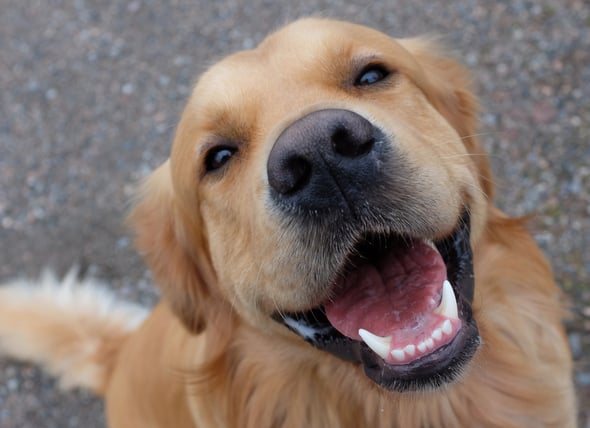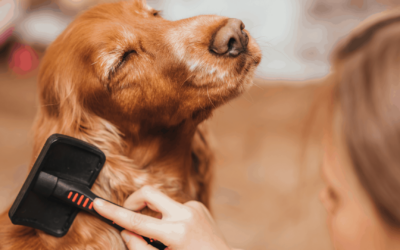Tips for Doggie Dental Care to Make Your Dog Smile

Like people, dogs need regular dental care. Regular dental care is essential for your dog’s well-being and good health. Although all dogs will have some degree of dental disease that causes discomfort while eating at some stage of their lives, pet parents can limit periodontal disease and tooth loss by feeding a high-quality and healthy dog food formula.
Yet, it’s cheaper to prevent dental issues than dealing with compromised teeth. The key to controlling plaque or tartar buildup is to keep your dog’s teeth clean. In this blog, we’re going to address dental care and what you can do to decrease infection and inflammation chances.
You Can Protect Your Dog’s Perfect Smile with Some Special Care
To maintain good dental health, your dog’s teeth need to be brushed every day. Because dental inflammation and pain can interfere with your dog’s wellbeing and affect his entire body, including his heart, you’ll need to take special care by feeding awhole-foods based diet that is free of carbs, additives and fillers.
You will also need to schedule regular trips to the veterinarian for dental checkups to prevent issues with eating, and to prevent dental infections, gum disease, and tooth loss.
When your furry best friend has dental problems, it’s a chronic inflammation source that can be linked to arthritis and cancer. Today, we know that antioxidants, zinc, and a wholesome diet can promote healthy gums and teeth.
Dogs are prone to getting plaque, tartar, and periodontal disease. Research shows that up to 80% of dogs and 70% of cats will develop periodontal infections by age three. If left untreated, periodontal disease will destroy your dog’s teeth and painfully infect gums and jawbones.
This can lead to debilitating illnesses resulting in expensive veterinary bills, and your dog may lose teeth due to decay.
Dental disease is a common problem seen in all dogs. This painful disease can affect your dog’s teeth and gums, as well as the supporting structures that keep his teeth in a place like the periodontal ligament or alveolar bone.
Canine Teeth
Although all dog breeds are susceptible to dental disease, some are more prone than others. This will depend on your dog’s breed, age, health, genes, the shape of their mouths, and even how long they take to chew on their food.
Dogs are carnivores like their wolf ancestors and have teeth designed for ripping and tearing meat apart. A dog has 28 deciduous (baby) teeth replaced with 42 permanent teeth, occurring between 2 and 7 months of age.
Different types of teeth have different functions, depending on where they are positioned within the mouth. The front teeth include 12 incisors and 4 large canine teeth (eye teeth).
These are designed to tear and hold. The back premolar and molars grind food into small pieces that allow for food to be swallowed safely.
The mouth has salivary glands which secrete saliva and lubricate food. This begins the digestive process. A dog’s tongue helps to guide food to the back of the throat and is important in licking up small pieces of food and drinking water.

How to Pick the Right Toothpaste for Your Dog?
To ensure good health, you’ll need to brush your dog’s teeth every day. Although all dogs will have some degree of dental disease that causes discomfort while eating at some stage of their lives, pet parents can limit periodontal disease and tooth loss by feeding a high-quality and healthy dog food formula. If you’re unsure which pet dental brands you should choose for your pet, here are some popular dental brands for pets.
- Vet’s Best Enzymatic Dog Toothpaste
- Petrodex Enzymatic Toothpaste for Dogs
- Nylabone Advanced Oral Care Kit
- Virbac C.E.T Enzymatic Toothpaste
- Premium Pet Dental Spray
- Pet Republique Dog Finger Toothbrush
- TruDog Spray me
- VeggieDent Dental Chews
- Emmy’s Best Premium Dog and Cat Breath Freshener
- Leba 111 Pet Dental Spray
Zinc is an important part of dental care and inhibits plaque buildup. Small dog breeds do well on 5mg of zinc daily, while large dog breeds may need 50mg. Look for doggie mouthwash with 5% zinc that you can administer into his mouth.
But make sure that it’s a pet mouthwash since dogs cannot have xylitol because it’s toxic to them. As usual, reach out to your veterinarian for the best advice on dental pet products for your dog.
Good Nutrition for Canine Dental Health
Healthy food is important in optimal dental health. Dental disease in cats and dogs can spread to other parts of the body via harmful bacteria in the blood. That said, dental disease can shorten your dog’s life!
A whole-foods-based diet free of carbs, additives, and fillers combined with regular trips to the veterinarian for dental checkups will prevent eating issues and help prevent dental infections, gum disease, and tooth loss.
With plaque, tartar, and gingivitis issues being similar to humans, dental pain is easy to spot. Studies have demonstrated that most dogs will have periodontal disease by age three. This can lead to other tissues in the body, like heart and kidney disease. Preventative methods like daily dental hygiene and dental chews can help keep your dog’s teeth and gums healthy.
Understanding that it’s easy to promote dental care by using antioxidants to combat inflammation means that you’ll know which vitamins to use to help with dental care. Vitamins like vitamin E and C work best when both are given together.
Vitamin C should be crafted with bioflavonoids and is most beneficial when given twice daily. Vitamin A promotes healthy gums in dogs, but don’t overdo this vitamin because it may have side effects.
You can feed liver and fish oil, as well as carrots, or ask your veterinarian about the pill form. As for fish oil, this helps promote gum health. Coenzyme Q10 also helps promote dental health and combats inflammation. Here’s the take on how you can spot if your dog has a dental issue.
Signs of Dental Problems in Dogs
- Bad breath
- Lopsided chewing
- Loss of appetite
- Pain when chewing
- Fever
- Unusual aggression
- Drooling
- Mouth and cheek pawing
How to Brush Your Dog’s Teeth?
You may think it’s difficult, and it may be the first few times you try brushing your dog’s teeth, but once you and your dog get the hang of it, it’s super easy to do. A dog’s mouth is usually neutral or alkaline. If your dog has an alkaline mouth, it may cause a faster plaque buildup and tartar rate. This leads to gum disease, and once this occurs, your dog’s mouth becomes acidic. Here’s what you can do:
- Purchase a few dog toothbrushes and different flavors of doggie toothpaste or gel.
- Check your dog’s teeth and mouth every week.
- Look for abscesses that need to be treated by your veterinarian.
- Easy to use toothbrushes like the finger toothbrush will slip over your index finger, and are an easy way to start.
- Washcloths or dental wipes can also be used to wipe your dog’s teeth.
- Visit your vet regularly for cleanings.
Chew Bones and Chew Toys to Clean Teeth
The American Animal Hospital Association (AAHA) adds that not all dental products for dogs are created equal, with some even capable of damaging your dog’s teeth. These include:
- Bones
- Antlers
- Rawhide
- Yak Milk Chews
- Rocks
- Sticks
AAHA also recommends staying away from pig ears, hooves, and bully sticks that may cause vomiting and diarrhea. Animal or synthetic bones may also cause choking and intestinal blocking. AAHA explains that you should choose your dog’s dental products by doing the following.
- Choose a dog chew treat that has the Veterinary Oral
- Health Council (VOHC) Seal of Approval.
- Feed your dog fresh veggies and fruits
- Utilize puzzle toys that require your dog to push or paw for kibble to fall out.
Popular Canine Dental Products
As a pet parent, keep updating yourself on the latest dental products for pets. Some awesome products come out every year, making pet dental care easier.
- Quaker Pet Group
- Silver Tails Line
- Orapup
- SER Enterprises
- Dental Cleanse for Dogs
- Ark Naturals
- Arm and Hammer Oral Care
- SynergyLabs
- PlaqClnz
- Zututh
- Royal Canine dental biscuits
The Dangers of Dental Disease
Bad Breath
If your dog’s breath smells bad, have his teeth examined by your veterinarian and professionally cleaned. Normal dog breath should have very little odor.
Loss of Appetite
Your dog may lose his appetite and may also have trouble eating. If your dog is dropping his food or has just stopped eating, he may have a dental problem. You’ll also notice bits of food in his water bowl.
Drooling
Your dog’s excessive drooling may be a sign of a painful dental condition and he may lose his appetite. He may also have something stuck inside his mouth.
Mouth & Cheek Pawing
Check the inside of your dog’s mouth for ulcers and inflamed, red gums. You’ll have to do so pretty fast since dogs tend to have little patience when having their teeth examined.
Feeling Sickly
Oral bacteria from dental problems can enter your pet’s bloodstream and cause serious health problems. Consult with your vet at the first signs of a dental issue.
Oral Surgery
Oral surgery tends to be favored in cases where the removal of one or more teeth is necessary. It is also done to repair fractured jaws in dogs. There are many new pain relief drugs and techniques used by veterinarians today. Your dog can undergo dental surgery with a minimal amount of pain and discomfort.
Gingivitis
Otherwise known as gum inflammation, gingivitis develops with periodontal disease. It weakens the periodontal ligament that anchors the tooth to the alveolar bone.
When periodontitis occurs, the tissue around the teeth is inflamed, and damage to the gingiva and periodontal ligament occurs. This causes the gums to recede and is known as the gingival recession. After that, the teeth will begin to loosen.
Advanced Stages of Periodontal Disease
When dogs have a more advanced periodontal disease, they may exhibit anorexia and decreased appetite, resulting in dramatic weight loss. They will also have difficulty chewing, swallowing food, and may even succumb to drooling. (ptyalism)
Many behavioral changes, such as lethargy, exercise intolerance, and mood changes like aggression, may occur because of how sickly your dog is feeling. Here’s what you can do to control plaque and calculus formation:
- Using dental hygiene diets like Royal Canin Dental
- Feeding Greenies Chewable treats
- Using Healthy Mouth products as a dental water additive
- Brushing your dog’s teeth regularly
- Schedule scaling and dental polishing
Using a combination of canine dental products together with probiotics, prebiotics, and supplements can help to neutralize the acid in the mouth and keep your dog’s teeth in tip-top shape. Remember that smaller dog breeds tend to have more dental issues than big dogs, and the earlier you start with dental care, the better.
Types of Dental Problems in Dogs
The common causes of pet dental problems include the following:
- Periodontal disease
- Infected teeth with abscesses
- Oral tumors
- Teeth that are misaligned
- Broken (fractured) or injured jaw with fractures
- Palate defects (such as cleft palate)
- Chipped teeth
It’s Never Too Late To Get Started
Whether you have dog dental insurance or not, you may be thinking to yourself, “Well, my dog is 10 years old and I’ve never really worried about dental care, as the dogs I grew up with never had that done, so why bother with this now?” Simply put, there are countless reasons to get started on regular dental care now, even if your dog is a senior and never had it before. In fact, there may be more reason to get into this practice now than when your furry buddy was a precocious puppy. Pet dental insurance can certainly help defray the costs of care, but not getting dental care at all could lead to enormous costs down the road.
As we’ve discussed above, if a dog’s teeth are allowed to simply rot, that process is often excruciatingly painful. You don’t want your dog to suffer, so put your pet dental insurance to work for you and preserve those teeth. It’s also not easy at all to feed a dog whose teeth are missing, rotted or barely present. As you’ll see below, a dog’s appetite can suffer as a result of periodontal problems and because of any antibiotic prescriptions your furry friend will need to stave off infections that arise in these situations.
Why Won’t My Dog Eat?
Dogs suffering from dental pain will not be able to eat properly. Infections and abscesses are painful and may prevent even the hungriest dogs from eating. Your veterinarian will help you to schedule professional cleanings and may also recommend a special dental diet.
Gum disease won’t develop around clean teeth. By brushing your dog’s teeth every day and feeding him a healthy diet, along with regular dental examinations, you’ll be helping to prevent gum disease.
When dogs have fractures of the bone or need restorative techniques like crowns, they may have problems chewing and eating. Wounds to the gums and or other soft tissue will need to be treated by a veterinarian. That said, if your dog refuses to eat because of dental trauma, a feeding tube may be needed while the dental injury heals. Dental cavities are similar to humans in that they are filled.
Keep in mind that a dog’s mouth and teeth are used to do the following:
- Pick up food
- Chew
- Swallow
If any of these functions are compromised because of dental problems or trauma to the mouth, a dog may not eat or drink, resulting in malnourishment and dehydration. Your veterinarian will need to do a complete oral examination, as well as a physical examination to make a correct diagnosis.

Do Antibiotics Affect a Dog’s Appetite?
Antibiotics are used in dogs to treat infectious diseases bacteria, and some microorganisms cause that. With so many different antibiotics classes such as penicillin, aminoglycosides, cephalosporins, quinolones, sulfonamides, tetracyclines, macrolides, and cephamycins, it’s easily possible that your dog may lose his appetite when on a prescribed antibiotic.
For antibiotic treatment to be successful, it’s necessary to ensure that the entire prescription is completed at the correct dosage. If dosing schedules are not followed, your dog may become ill again or be reinfected.
With appetite disorders being common in sick dogs, a veterinarian may recommend drug treatment to stimulate appetite for dogs that refuse to eat. These drugs all work in different ways, and your veterinarian will prescribe one that works best for your dog. CBD pet treats may also help improve appetite and may help relieve dental inflammation and pain.
Side Effects of Antibiotics
- Nausea
- Vomiting
- Diarrhea
- Lack of appetite
- Drowsiness
- Drooling
- Difficulty swallowing
What to Do If My Dog Won’t Eat?
Once your veterinarian has ruled out all health problems, you can try some of the natural solutions below:
- Opt for a high-quality homemade dog food formula with added vitamins and supplements for immune support.
- Introduce organic plain yogurt with a sprinkling of blueberries for optimal health benefits.
- Raw carrots remove plaque and freshen breath.
- Vegan, homemade dog food recipes boost overall health.
- Lessen the number of daily treats and opt only for healthy treats.
- Introduce probiotics and digestive enzymes as natural appetite stimulants.
- Opt for steering clear of cheap commercial pet foods with natural whole foods.
- CBD dog treats or oil may help to stimulate appetite
- Prepare your dog’s favorite meal of salmon and veggies or lamb, kale, and couscous to increase appetite. Puree, if needed, for dogs that are unable to eat due to dental pain.
If your dog is having a hard time eating, consider high-quality, homemade dog food in the same way that people do. Adjusting portion size with varying recipes, according to your dog’s preferences, may do the trick! As usual, reach out to your veterinarian for balanced, whole-food recipes.
A combination of a healthy diet and herbal treatments, and acupuncture may also help your dog eat. Dental hygiene should be a priority, like great veterinary care and healthy nutrition, and is best practiced year-round to ensure your dog’s wellbeing. Today there is top–of–the–line electric toothbrushes for dogs, pet dental floss, water additives, and tongue scrapers to keep your dog’s tongue germ-free.
If you’ve recently become the proud pet parent to a wonderful dog breed, you’ll need to make sure that brushing your dog’s teeth becomes an everyday thing! It takes a few minutes and should be part of your dog’s daily routine. Start during puppyhood, and remember to take out pet insurance like Odie Pet Insurance for as low as $14.99 a month.
Regular dental care will make the difference between having a healthy dog and one that may be prone to periodontal disease, and plenty of veterinary visits.
Motivate yourself to begin today! Children love participating too! As usual, always be around too, and consult with your veterinarian for twice-yearly dental cleanings. Twice yearly cleanings should always be done under anesthesia, as recommended by the American Veterinary Dental College. (AVDC)
You can read more about pet insurance and dental care here.
You can also read our other blog posts to get even more info on keeping your pet healthy.
Resources



